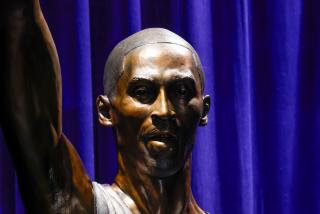He’s Still Coach Bryant a Decade After Death : Football: His legacy lives at Alabama, where Stallings is comfortable in his shadow.
TUSCALOOSA, Ala. — It’s been 10 years since Bear Bryant coached a football game at the University of Alabama. But his presence is everywhere.
Over there is the Paul W. Bryant Museum. That’s right next door to the Bryant Conference Center and just down the street from Bryant-Denny Stadium. All, of course, located on Paul W. Bryant Drive.
One block away is the Bryant Athletic Dormitory, which houses the players who carry on the legacy left behind by the Bear--”Coach Bryant” as he was known to nearly everyone associated with the program.
“Even though Coach Bryant has been dead for 10 years now, most of us at Alabama don’t want to accept that,” says the current coach, Gene Stallings.
Bryant died Jan. 26, 1983, about a month after coaching the final game of a 38-year career in which he won more games, 323, than any other major-college coach. But Stallings and others still speak of him in the present tense--as if he’s still on his famous tower overlooking the practice field and his beloved Crimson Tide.
In a sense, he is.
“I don’t think he’ll ever go away,” says Tommy Wilcox, a defensive back who played on Bryant’s final team. “He’s still as much an emblem of the University of Alabama as he was the day he left.”
But the Bryant legacy can be a heavy load to bear.
Ray Perkins, a former Alabama player, took over the coaching job in 1983 but left after only four years to return to the NFL. Despite his Crimson Tide connections, he created a furor when, shortly after being hired, he ordered Bryant’s practice tower be taken down.
Perkins was succeeded by Bill Curry, an outsider who was never accepted by the Bryant legions. One of Curry’s first acts was to have Bryant’s tower rebuilt. But despite that, and a 26-10 record in three seasons, Curry never was made to feel comfortable.
After Curry went to Kentucky three years ago, Stallings got the call that would have come in 1982 if Bryant had been given his way.
“He made it clear to anybody who talked to him privately that he wanted Stallings to have the job,” says Mickey Herskowitz, a columnist with The Houston Post who developed a friendship with both men and wrote the book, “The Legend of Bear Bryant.”
Maybe it was good that Stallings’ chance didn’t come until later. Maybe if he had gotten the job 10 years ago Alabama would not be 12-0 now, ranked No. 2 and playing for a national championship against top-ranked Miami in the Sugar Bowl on New Year’s night.
“I don’t know if he would have been as successful,” Herskowitz says. “Knowing how difficult it is even now for Stallings, who worships the memory of Bryant, to compete with that memory, imagine what it must have been like for (Perkins).”
But Stallings, unlike his two predecessors, truly has no problems with the Bryant mystique.
“It’s not intimidating to me at all because I loved Coach Bryant so much,” Stallings says. “I’m not in competition with him. I’m just a guy trying to win a few games.”
Stallings has done more than just win a few games.
Since losing his first three contests as the Tide coach in 1990, he has posted a record of 30-3. Alabama was 11-1 last season, winding up No. 5 in the country, and has a chance on Jan. 1 to win its first national title since 1979--the last of six won by Bryant-coached teams.
“There’s such a great feeling again in Tuscaloosa because of what Coach Stallings has done,” said Bob Baumhower, a defensive tackle at Alabama in the 1970s who returned to the city after retiring from the Miami Dolphins in 1988. “He’s bringing back that feeling this town had when Coach Bryant was here.”
That feeling went beyond mere victories on the football field.
Bryant began winning national titles at Alabama in the 1960s when the state was embroiled in the civil rights movement. So while the governor stood in the schoolhouse door to block integration, football brought a different kind of notoriety.
“He gave the state something to be proud of,” says quarterback Jay Barker, who was only 7 when Bryant won his last national crown. “With education and all the other things, we’re not exactly at the top of the list. But football and Coach Bryant put us on top.”
Perkins was tapped to carry on that tradition, but he angered other former players when he tried to break the links with the past, such as taking down Bryant’s tower.
“Coming in, I knew I was going to get some flak for some of the changes I had to make,” Perkins says. “He (Bryant) and I talked about that at his house one evening.”
Perhaps if Bryant had lived, he would have been around to endorse his successor’s changes. “Certainly he would have backed whatever decisions I made,” says Perkins, who now coaches at Arkansas State.
Curry was another story altogether. He had no ties to Bryant either as a player or coach, and that ultimately led to his downfall.
“I think even though he was successful, people wanted somebody from Alabama, somebody who had played for Coach Bryant or coached for Coach Bryant,” Wilcox said. “Somebody from within the family.”
Sometimes, maybe even that would not have been enough.
“There will never be another Bear Bryant,” tight end Lamonde Russell said soon after the Tide lost the 1990 Sugar Bowl to Miami. “That’s one of the biggest problems in the state of Alabama.”
Still, Stallings has succeeded, even though he had a terrible head coaching record (50-79-2) when he came to Alabama.
“He doesn’t feel pressure from Coach Bryant’s presence,” Baumhower said. “He’s a part of Coach Bryant’s presence.”
The Bryant presence is perpetuated by his ex-players, many of whom settled in Alabama after their playing days were over. Wilcox was a native of Louisiana, but he now makes his home in Tuscaloosa. Baumhower grew up in Florida and played for the Dolphins, but he returned to Tuscaloosa to open a chain of restaurants.
“They feel they have contributed to the program, and I’m not so sure some of them don’t feel like they are still on scholarship,” says Jim Goostree, the executive athletic director who came to Alabama in 1957--the year before Bryant arrived to revive a moribund program.
While Bryant’s former players have come to Tuscaloosa to keep alive his legacy, the Bear is not buried there. Instead, Bryant’s grave is marked with a simple headstone, nothing more, in the middle of Elmwood Cemetery in Birmingham.
Though more than a half-million people lined the route the funeral procession took Bryant’s body from Tuscaloosa to Birmingham, there are no signs at the cemetery to draw flocks of his fans. There is only one symbol, and it is not explained for those who do not know: A simple, crimson strip is painted on the road that gently winds from the cemetery gates to his Bryant’s grave.
While Bryant’s admirers decorate his grave all year with flowers and other reminders, not everyone is so familiar with what his deeds.
Cornerback Antonio Langham wasn’t aware of Bryant’s accomplishments when he came to Alabama in 1990. He only wanted to play for a winner.
“I really didn’t know that much about him,” he admits. “I knew they had a great tradition at Alabama but that was basically all I knew about Coach Bryant.”
It may sound like heresy to some, but Langham says it’s time to put the Bryant era to rest.
“Coach Bryant was then. He left a mark nobody will forget. But we’re under Coach Stallings now. It’s a new time here. We’re pretty much doing a whole different thing than what Coach Bryant did when he was here.”
More to Read
Go beyond the scoreboard
Get the latest on L.A.'s teams in the daily Sports Report newsletter.
You may occasionally receive promotional content from the Los Angeles Times.










